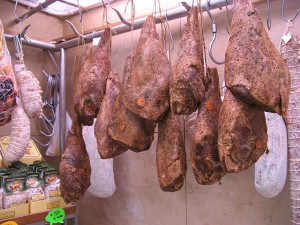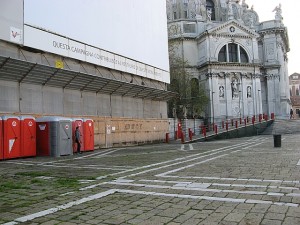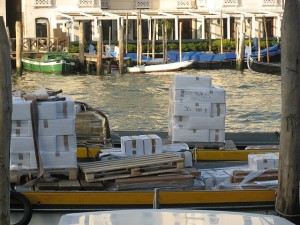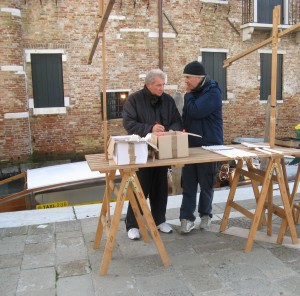Of course you already know that “La Madonna della Salute” does not mean “Our Lady of the Salute.” She is Our Lady of Health, and every year on November 21 everyone in Venice who can walk, and even some who can’t, make the pilgrimage to her church to offer a candle and say however many prayers are filling their hearts.

Yesterday was not a propitious day, meteorologically speaking. For two or three days the Gazzettino had been feverishly predicting acqua alta of 120 cm [four feet] that morning. (It didn’t happen.) There was plenty of water, however, in the form of a frigid rain. It wasn’t heavy, but it was determined, the kind of rain that isn’t thinking about anything else. And it got dark early.

There had also been an anxious sub-theme, which began circulating several days early, on the impending castradina famine. Castradina the basis of the traditional dish for this festival, a soup made of cabbage and a haunch of mutton which has been dried, smoked, aged, slathered in dark malodorous spices, and possibly even beaten with sticks and dead-blow hammers. It’s an impressive little piece of meat.
But this year, the Muslim festival of Eid al-Adha, or Festival of Sacrifice, fell in the same period. Which meant that the general supply of castradina — which has never been huge, seeing as the tradition had fallen into general disuse — had suddenly shrunk to almost nothing. I have now learned that Muslims favor this foodstuff for their religious observance, and that they offered a better price to the few remaining wholesalers who carry it.
This is amusing, in a way (it takes so little to amuse me), because for years many people didn’t care about castradina. We’ve had Venetians over to dinner who had never eaten it. We’d see these hunks of black flesh hanging in the butcher shops and would wonder what they did with the ones they didn’t sell.
But in the past year or two, castradina has come back into fashion. So Venice, according to the Gazzettino, was pullulating with desperate people seeking castradina by any means, in any place, at any price. I can’t think of a credible substitute. You couldn’t fake it even with tofu.

Back to the weather. It was cold, dark, and wet. Just what I think of as perfect weather for this feast, though the women in the mink coats were thwarted by the rain. As you know, they come out in force on this day even in the driving sun. The need to show off their fur is just too strong. If you’re wearing beaver or seal, fine. But minks do not like rain any more than their humans do. I kind of missed seeing these self-contented matrons in their luscious garb. They do love it so. Lino calls this the feast of Our Lady of the Fur Coats.


This year, to my surprise, we got into the church without having to battle a rugby scrum, and we walked right up to the candle-lighting station and handed over our candles. This was an odd but very pleasant sensation. Last year there was such a crush of people that I honestly thought we’d be trapped there holding our candles till Christmas Eve.
Then, as usual, we joined the file of people who elected to walk past the high altar and venerate the little Madonna on the other side, crossing themselves and tossing some cash, and walking out through the sacristy. We found two seats in the heavy wooden choir stalls and sat down to watch people go by. Even though there weren’t massive crowds, the flow was steady. So far, so normal.
You can’t force pious thoughts. If you try, they just slide off your brain. So I sat there not thinking at all, somewhat lulled by the rosary recitation floating over from the other side. And then a thought came to me — more a realization than a thought. I realized that we were being faithful.
All those thousands of frantic, distraught Venetians had been watching people die of the plague all around them till all they had left to offer in exchange for their lives was to promise the Virgin that if she would intercede and save what was left of the city, they would build her a church and come to offer her candles and gratitude every November 21 forever. And after 380 years, people (us) who are so far away from the original promisers that their vow could be thought of as symbolic, or even meaningless, are still maintaining that vow.
Crumpled-up little old people, children of every shape and temper, families of various nationalities, teenage boys, an assortment of tourists — anybody who was there formed another link in the chain tying us to those helpless, despairing people who made a promise that they believed we would keep.
And we did. And we will.

